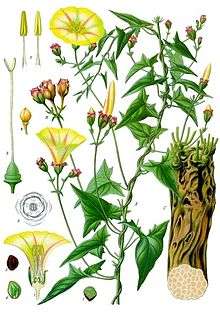Convolvulus scammonia
Convolvulus scammonia, known commonly as scammony, is a bindweed native to the countries of the eastern part of the Mediterranean basin; it grows in bushy waste places, from Syria in the south to the Crimea in the north, its range extending westward to the Greek islands, but not to northern Africa or Italy.
| Scammony | |
|---|---|
 | |
| Scientific classification | |
| Kingdom: | Plantae |
| Clade: | Tracheophytes |
| Clade: | Angiosperms |
| Clade: | Eudicots |
| Clade: | Asterids |
| Order: | Solanales |
| Family: | Convolvulaceae |
| Genus: | Convolvulus |
| Species: | C. scammonia |
| Binomial name | |
| Convolvulus scammonia | |
It is a twining perennial, bearing flowers like those of Convolvulus arvensis, and having irregularly arrow-shaped leaves and a thick fleshy root. The dried juice, virgin scammony, obtained by incision of the living root, has been used in medicine as scammonium, but the variable quality of the drug has led to the employment of scammoniae resina, which is obtained from the dried root by digestion with alcohol.
Both have extensive medical effects and uses[1]
The active principle is the glucoside scammonin or jalapin, C34H114O6. The dose of scammonium is 5 to 10 grains, of scammony resin 3 to 8 grains. Like certain other resins, scammony is inert until it has passed from the stomach into the duodenum, where it meets the bile, a chemical reaction occurring between it and the taurocholate and glycocholate of sodium, whereby it is converted into a powerful purgative. Its action is essentially that of a hydragogue, and is exercised upon practically the entire length of the alimentary canal. The drug is not a cholagogue, nor does it markedly affect the muscular coat of the bowel, but it causes a great increase of secretion from the intestinal glands. It acts in about four hours. In large doses it is a violent gastrointestinal irritant. In consonance with the statement that scammony acts only after admixture with the bile, is the fact that hypodermic or intravenous injection of the drug produces no purgation, or indeed any other result. The drug frequently kills both roundworm and tapeworm, especially the former, and is therefore an anthelmintic. It is not largely used, but is very effective in the treatment of severe constipation, especially in children.
References
